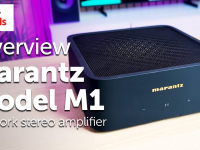
Arcam’s original irDAC proved to be one of the brightest stars of the DAC resurgence that has taken place over the past few years. Looked upon kindly for its detailed yet neutral sound, Arcam saw awards bestowed by seasoned critic and first-time consumer alike. Can the irDAC II fare as well?
A gap of three years between releases has given Arcam plenty of time to look and see what could be changed (not always an easy task in a product that’s won so many awards!), but their findings have been fairly extensive, proving the Cambridgeshire-based company are keen not to rest on their laurels.
The biggest change under the bonnet is a switch to a new DAC chip: the ESS Sabre ES9016, a brand and chip that has proven to be extremely popular and successful with other high-end DAC manufacturers in recent times. Key to this change is the Sabre‘s flexibility, brilliant sound quality and compatibility with cutting edge formats, including DSD 128, which is seen here for the first time on any Arcam DAC.
The connectivity count is high, with the Arcam featuring twin optical and coaxial inputs, a USB socket, Bluetooth, and another Arcam first, a headphone output. The optical connections are capable of sample rates up to 96kHz, the coaxial up to 192kHz and the USB up to a whopping 384kHz, all of which means that Hi-Res audio fans will have plenty to love. Bluetooth is AptX capable, giving mobile users a quick and easy connection method that won’t skimp on quality.
The headphone output is taken from Arcam‘s top-of-the-range A49 amplifier and is capable of driving anything from 30 to 600 Ohm cans. During testing we tried a number of headphones, from in-ears through to top tier over-ear designs and found the irDAC II to be an assured and very capable headphone amp, giving plenty of punch and drive to the music and with plenty of power on tap to keep things under control nicely.
Owing to its inclusion of both a fixed and variable output, the Arcam can double up as a digital pre-amplifier for those who’s system features no analogue equipment. Simply selecting the right set of (nicely labelled!) outputs will give the irDAC‘s remote control the option to change volume up or down, or just to work as a standard DAC. That remote also allows for switching between devices, and is the control for the headphone output, too.
 Our listening was done via USB, from CD using its digital output, and Bluetooth direct from a mobile. As per usual, the DAC was given 48 hours to warm up before we settled into serious listening.
Our listening was done via USB, from CD using its digital output, and Bluetooth direct from a mobile. As per usual, the DAC was given 48 hours to warm up before we settled into serious listening.
First up was the sophomore release from Seattle’s Fleet Foxes, Helplessness Blues. Whilst the album was praised upon initial release, Fleet Foxes‘ eponymous debut was held in such high esteem that it was always going to be a tall order to top it, and the band went on indefinite hiatus not long after. Helplessness Blues is certainly a more introspective work, focusing more on the lyrics of frontman, Robin Pecknold, but still giving a share of the spotlight to the full group harmonies. The first track, Montezuma, sounded glorious. The Arcam was able to layer those harmonies wonderfully, whilst Pecknold‘s vocal was sat squarely in the centre of the soundstage. There was no hint of brightness, but also no unwanted hazy warmth, Arcam clearly setting neutrality high up their list of requirements once again. The album’s more upbeat numbers kicked along nicely, too, showing a confident and fun performer, with plenty of vigour and life imbued into the tracks. It certainly left us pining for album number three, should it ever arrive!
The Dave Brubeck Quartet‘s album, Time Out, is one of the biggest selling jazz records of all time, and its lead single Take Five, one of the genre’s most famous and covered songs. A fantastic hi-fi test track, Brubeck‘s instantly recognisable chords are complemented wonderfully by the double bass of Eugene Wright, and the perfect drum licks of Joe Morello. Tied together by the soaring alto sax of the song’s composer, Paul Desmond, it’s obvious from the first listen why this is one jazz track that almost everybody has heard. Morello‘s drum solo is the centrepiece here, and the little Arcam gave them real heft. Desmond‘s alto sax, too, wailed, with no shrillness, plenty of oomph and a brilliant sense of scale. For a track etched into the brains of so many music enthusiasts, the Arcam still gave a spine-tingling performance that had us grinning from ear to ear.
The irDAC II continued to shine as the set list got longer. From classical to pop, jazz to rock, the Arcam‘s even-handed approach meant that all comers were given the same treatment. Plenty of detail was on offer, with insight into even the most difficult of tracks made effortless. Despite this neutral performance, music still kicked and had plenty of life. This didn’t seem due to an artificial boost to the upper-mid range and treble, more just an innate sense of ‘musicality’ that the Arcam‘s engineers seemingly have oozing out of their pores.
Anyone in the market for either a new DAC, headphone amp or digital pre-amplifier will find a huge amount to love here. Hugely recommended.
For this and many other digital-to-analogue converters, call or pop into your local store today!
Shop for DACs with Richer Sounds.
Author – Chris, Liverpool store





